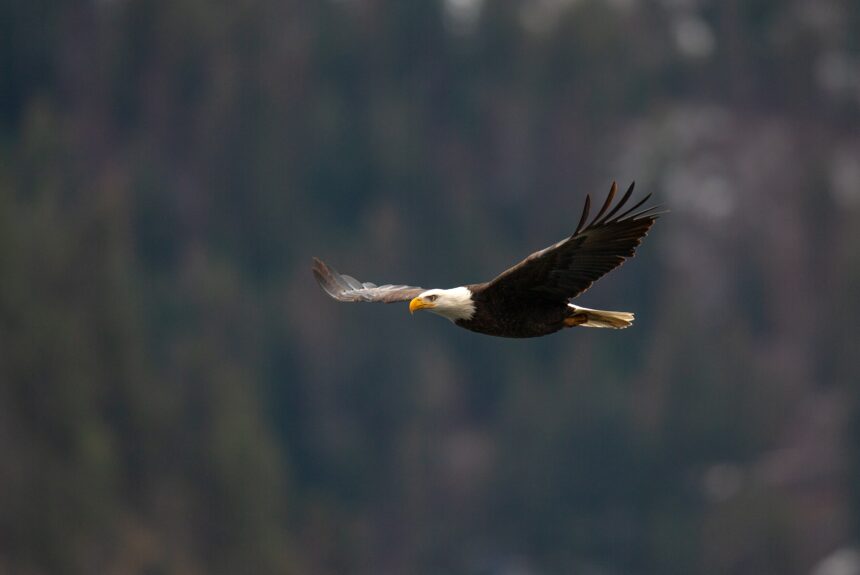It is a tale as old as wind energy. A turbine goes up, eagles fly into them, and a nightmare for both conservationists and renewable energy advocates is perpetuated. Government efforts to mitigate this problem have been quite unsuccessful. Now, a new report from the free-market Property and Environment Research Center (PERC) offers a better path forward for both eagles and wind energy.
>>>READ: PERC Report: Regulations Are Making Wildfires Worse
The current method of resolving conflict between eagle populations and wind turbine development is well-intentioned but ineffective. It is estimated that turbine strikes kill between 140,000 and 328,000 birds per year. While this number encompasses all bird species, it is particularly troubling for protected birds such as bald and golden eagles.
To try and combat this, the federal government has developed a permitting structure that allows for a specific number of birds per project to be killed. Explaining this process, the PERC wind report notes:
“The U.S. Fish and Wildlife Service reviews permit applications and considers the level of sustainable take [incidental and unintentional deaths] for each regional eagle population. Permits require a one-time fee as well as additional fees for five-year reviews and renewals. Regulatory changes in 2016 extended the timespan of eagle-take permits for wind projects from five to 30 years and increased the allowable incidental take without requiring compensatory mitigation from 1,000 to 4,200 bald eagles over the life of each permit…Project owners are not required to possess a permit but face heavy fines and possible criminal charges if caught taking an eagle without a permit.”
The problem with these permits? They are inefficient, one-size-fits-all, and have the same issues as the Endangered Species Act when it comes to motivating stakeholders to actually work toward species conservation. These permits come with maximum deaths allowed without any real incentive to not kill up to that number, they have a fixed cost, and they cannot be transferred.
PERC suggests a better way forward: Creating a market for eagle take that allows wind developers and operators to earn money while incentivizing them to take part in conservation efforts. Why would this be effective? The report explains:
“By effectively creating a market for eagle take, wind energy producers would be forced to consider the marginal cost of killing an eagle and adjust their behavior accordingly. They would essentially balance the cost of reducing the risk of killing an eagle against the price of a permit that would be required if an additional eagle were killed. Such a policy would create a tradable property right and could generate cost-effective eagle conservation if the market were sufficiently competitive and transaction costs were low.”
How would this be implemented in real life? It would start with permitting reform that allows for trade between wind operators.
For example, say two neighboring wind farm operators each received one permit that allowed for a low number of incidental eagle take. However, one of the operators was much more concerned with conserving eagle populations while the other was concerned about the penalties the operation would accrue if the eagle take was higher than what the permit allowed. In this situation, the conservationist operator could sell their permit to their concerned neighbor, making some money while opting to conserve as many eagles as possible.
>>>READ: The Endangered Species Act Needs Fixing; Better Incentives for Landowners Could be a Start
To be sure, real-life trading would be more complex than the example listed above. It would require a developed trading system and third-party monitoring for accountability. But this sort of transferable permit system would prompt better conservation of eagles from the market, not from the government.
The U.S. Department of Energy wants wind energy to meet 20 percent of American electricity demand by 2030 and 35 percent of demand by 2050. Wind energy is not going away anytime soon, so it is important that as conservation issues like this arise, adjustments are made. PERC points out the fact that this sort of permitting could have other positive impacts on wind development:
“Transferable incidental take permits could limit the overall number of eagles killed annually while encouraging wind energy generators to decrease take by locating in lower-risk areas, altering turbine design, or implementing other mitigation measures to reduce risk.”
You can read the complete report here. It is important for America to advance in renewable energy generation and to protect species that need protecting. Market-based solutions like this help achieve both goals.
Kelvey Vander Hart is a native Iowan, a member of the American Conservation Coalition, and a communications specialist at Reason Foundation.
The views and opinions expressed are those of the author’s and do not necessarily reflect the official policy or position of C3.
